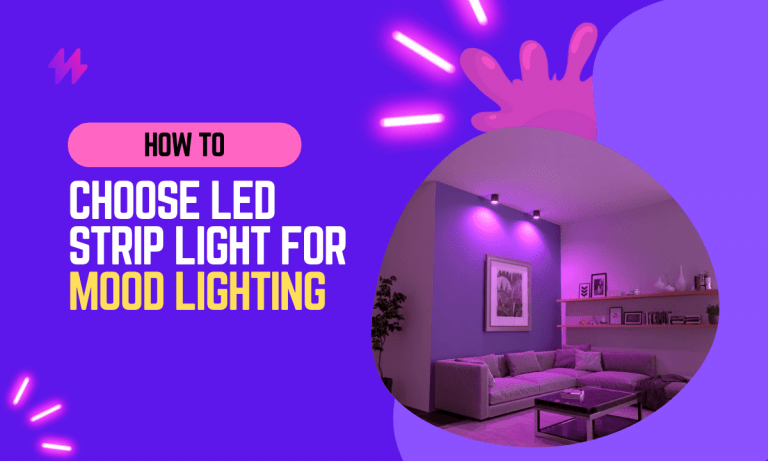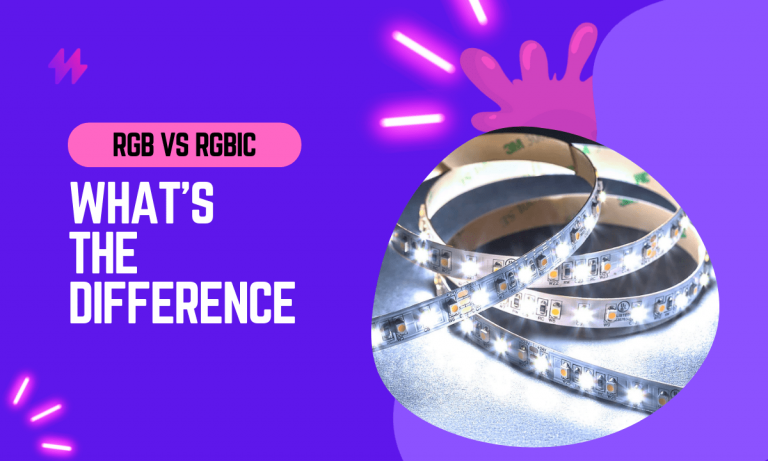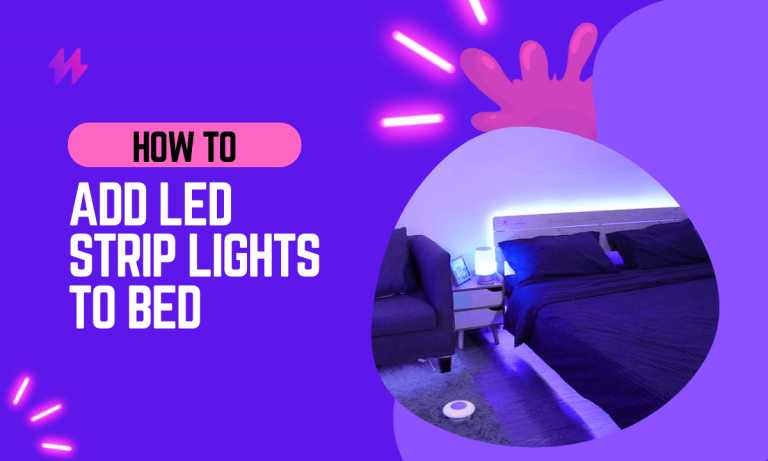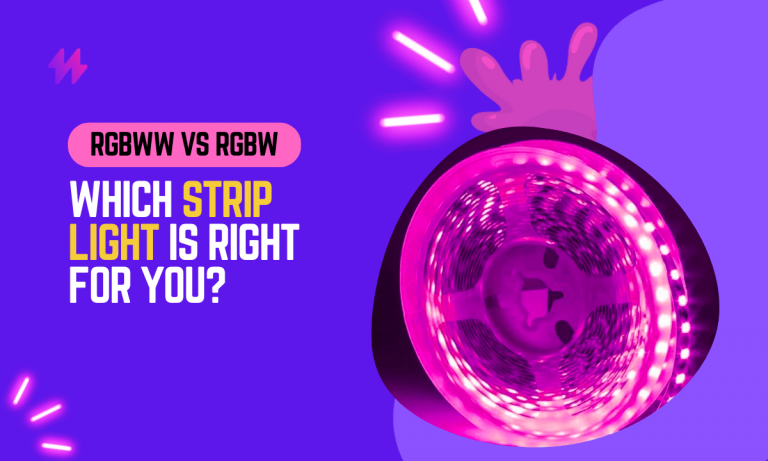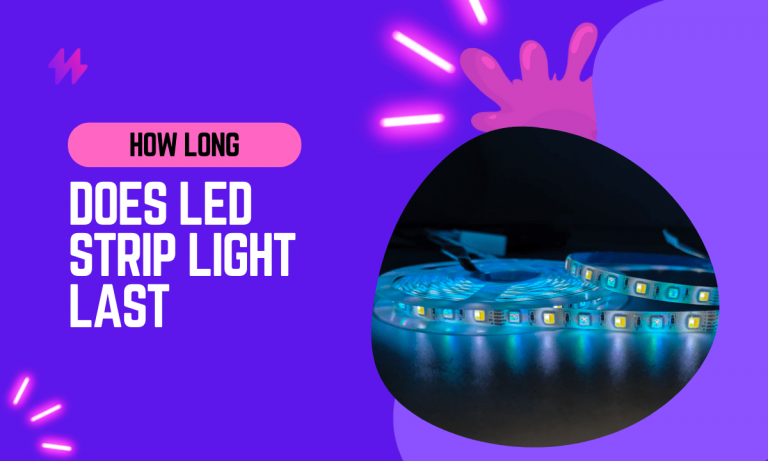Can You Put LED Light Strips on Wallpaper?
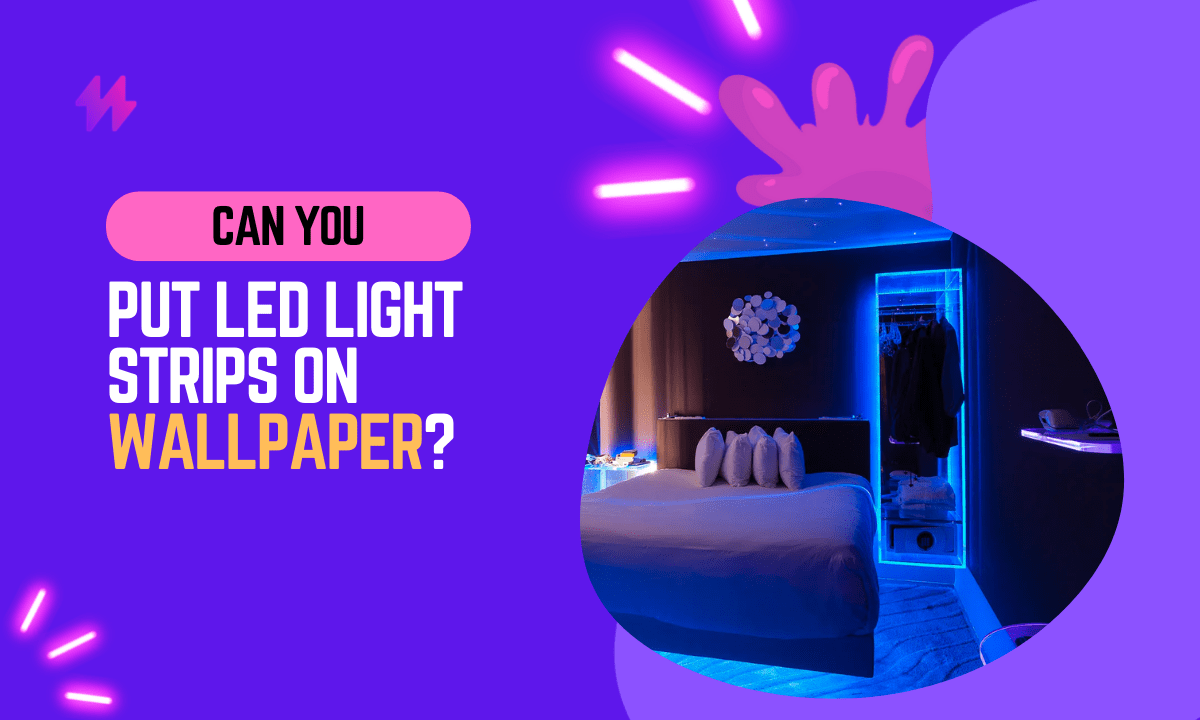
LED strip lights are a popular way to light up a room. They can be used in a variety of ways, from creating ambiance to providing task lighting. And while strip lights are often used under cabinets or around furniture, there is no reason you can’t use them on the walls too. In fact, many people are starting to do just that.
But LED strip lights aren’t just for adding light – they can also be used for decoration. Wallpaper provides the perfect canvas for displaying these lights and allows you to be creative with your lighting design. But can you put LED light strips on wallpaper?
Let’s find out in this lighting guide.
Using LED strip lights on wallpaper is an innovative way to enhance the aesthetic look of a room while providing a permanent light source. However, it’s important to choose the right adhesive strips to ensure that the light strips adhere properly without causing wall destruction.
Can You Install LED Light Strips on Wallpaper?
Yes! LED light strips are perfectly suitable to stick on wallpaper. But before you start, there are a few things you should be aware of.
When installing LED strip lights on wallpaper, it’s crucial to consider the surface material and the adhesives used to ensure a damage-free wall surface. Additionally, utilizing self-adhesive tape designed for light fixtures can help maintain the polished look of the wall paint while allowing the bright beams of light to shine through without any issues.
Can You Put LED Light Strips on Wallpaper? | Wallpaper Adherence Considerations
First and foremost, you’ll need to ensure that the wallpaper properly adheres to the wall. If not, then you risk having your lights fall off during installation or soon after.
Installing LED lights on wallpaper can create an impressive ambiance, transforming any space into a dazzling display. Always ensure the installation surface is clean and free of dust, as this will improve the effectiveness of the strong adhesive used, reducing potential lighting issues later on.
Ensure the Wallpaper Surface is Pristine for Optimal LED Light Strip Application
The next thing you’ll want to do is make sure the wallpaper surface is clean. This will ensure that the adhesive on the back of the LED light strip will stick properly and last longer.
To achieve an optimal installation of LED strip lights on wallpaper, it’s vital to use clean sponges or paper towels to prepare the surface adequately. This diligence not only helps in achieving a clean look but also ensures that the strong adhesive will keep the light strips securely attached to the wall without the risk of damage from any leftover adhesive.
Ensure You Select the Right Lighting Strips for Your Wallpaper
The type of wallpaper you have (vinyl or non-vinyl) will influence the kind of LED strip lights you should use. For vinyl wallpaper, we recommend using an adhesive-backed strip light. This is because they provide a strong bond that won’t pull away from the wall over time.
For non-vinyl wallpaper, you can use either an adhesive or magnetic strip light.
Choosing the appropriate type of LED strip lights according to your wallpaper can elevate the aesthetics and functionality of the room. To prevent paint chipping and ensure your light strip LEDs shine bright, consider using silicon glue or compatible adhesives that can securely attach to paint surfaces without causing wall damage.
Test Your LED Light Strips Before Applying to Wallpaper
Once you have the right lighting strips, it’s important to test them before you stick them up. This will ensure that they are working correctly and won’t be affected by the wallpaper material. And if they don’t pass the test, then you’ll need to find a different solution.
Before attaching your LED strip lights to the wallpaper, consider testing the brightness to ensure they meet your expectations. If you’re working with painted walls, using a compatible adhesive like hot glue can help secure the strips without causing any wall damage or wallpaper issues.
Ensure Quality Adhesives for Optimal LED Light Strip Application on Wallpaper
Finally, make sure you use a good-quality adhesive when putting up the LED light strip. This will ensure that it stays stuck to the wall and won’t peel off over time.
Ensuring that the LED strip is properly attached with a good-quality adhesive will help prevent potential wall woes and keep the light strips from causing any damage to your wallpaper over time. Investing in several adhesives that are designed specifically for this purpose will enhance the durability and functionality of your lighting setup.
Avoid Overcrowding: Do Not Use Too Many Lights In One Spot
It’s also important to note that when installing LED light strips on the wallpaper, you should not use too many in one spot. Too much can be overwhelming and could cause the wallpaper to bubble or warp. So be sure to space the lights evenly for a more pleasing effect.
When installing LED light strips, it’s essential to use a tape measure to ensure that they are spaced correctly, which helps avoid overwhelming your wallpaper with too much lighting in one area. Additionally, maintaining a consistent distance between the strips allows the light to shine bright, creating an enchanting glow throughout the room without risking damage to your wall paints or wallpaper.
Reasons to Use LED Strip Lights on Wallpaper: Benefits and Tips
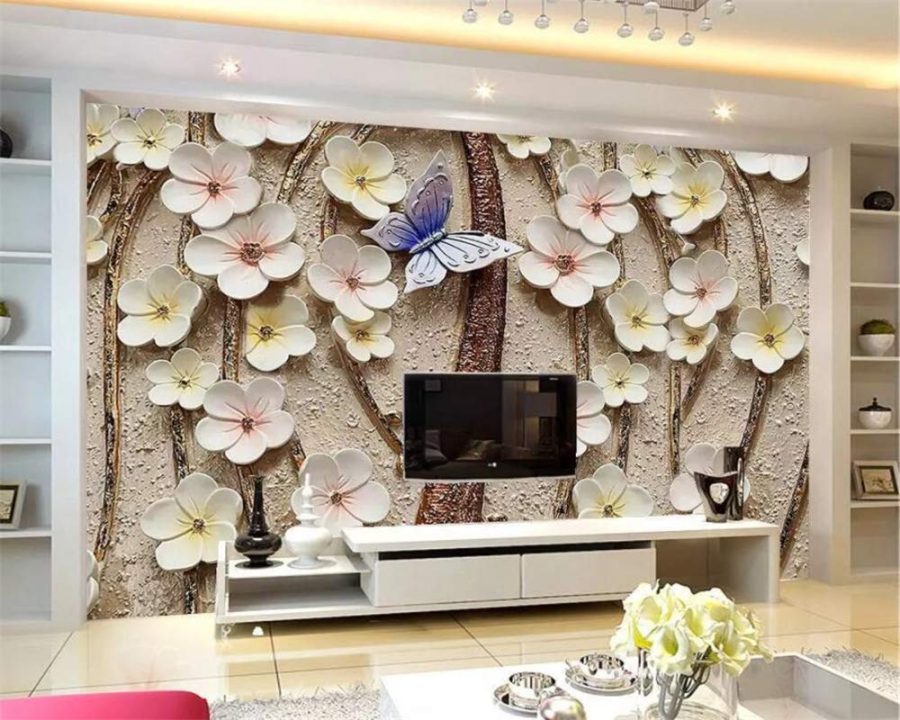
We did some research, and it turns out that there are multiple benefits of putting LED strip lights on the wall and wallpapers:
Incorporating LED strip lights into your new decor can elevate the ambiance of any space while providing significant lighting capacity. By ensuring that the right adhesive is used, you can avoid potential light strips damage and maintain the aesthetics of your wallpaper, ensuring the ideal glow throughout the room.
LED Strip Lights: Effective on Smooth Surfaces
LED strip lights are perfect for smooth surfaces, like wallpaper. The adhesive backing ensures that the light strips stay in place and won’t peel off with time.
When using LED strip lights on wallpaper, it’s important to ensure that the adhesive is compatible with the material to prevent damage. By choosing the right tapes or adhesives, you can make sure your LED strip is securely adhered, allowing the space shine bright with the same LEDs consistently over time.
Flexible LED Strip Lights: Perfect for Your Wallpaper Decor
LED strip lights are incredibly flexible and can be used in various ways. You can use them to highlight a feature wall or create an accent light for your bedroom.
The versatility of LED strip lights allows them to be strategically placed in various settings, from homes to commercial spaces, enhancing both functionality and aesthetic appeal. When selecting your installation methods, consider ensuring that the internal wires and connectors are appropriately managed to maintain a neat and clean aesthetic, which is often beneficial if you wish to use ledyi or light clips for a tidy setup.
Lightweight LED Light Strips: The Ideal Choice for Your Wallpaper
LED strip lights are incredibly lightweight, meaning they won’t put a strain on your wallpaper. This makes them perfect for walls that can’t support the weight of traditional lighting fixtures
Using LED strip lights is a smart choice for enhancing your decor without risking damage to your wallpaper. By ensuring the right adhesive and installation methods are employed, you can keep your walls intact and allow the LEDs to work their magic, creating an inviting atmosphere that complements the design of any space.
Customizable LED Light Strips: Enhance Your Wallpaper Decor
When you install LED light strips on the walls, you can customize the look to fit your own style and taste. You can easily create any mood or atmosphere you like, making them perfect for any room in the house.
LED light strips offer impressive versatility, allowing for personalization of your space while ensuring that compatibility with your wallpaper is maintained. By carefully selecting materials and installation methods, you can create a stunning look that complements your wall papers beautifully and ensures the LEDs work effectively without causing damage.
Conclusion: Key Takeaways for Using LED Light Strips on Wallpaper
In conclusion, installing LED light strips on wallpaper can be a feasible option for enhancing the aesthetic appeal of a room with ambient lighting, but it requires careful consideration and planning to avoid damage to the wallpaper. The adhesive backing of LED strips, while typically not heavy, can potentially compromise the integrity of wallpaper over time, especially if the wallpaper is delicate or not securely attached to the wall. Therefore, it is crucial to assess the quality and condition of the wallpaper before installation. For wallpapers that are robust and well-adhered, LED strips can add a dynamic and customizable lighting element that transforms the space without intrusive installation procedures.
Moreover, for those concerned about the potential damage or who have premium or delicate wallpaper, alternative methods of installation should be considered. Using clips, mounting tracks, or velcro strips provides a non-permanent installation method that can protect the wallpaper from the adhesive while still allowing the flexibility to change the lighting as needed. These methods ensure that the LED strips can be removed or repositioned without tearing or marking the wallpaper. Implementing LED strips in this manner not only preserves the underlying wallpaper but also allows for creative lighting solutions that can be adapted or updated according to decor changes or functional needs. By carefully selecting the installation method and type of LED light strips, homeowners can beautifully illuminate their spaces while maintaining the pristine condition of their decorated walls.
Can You Put LED Light Strips On Wallpaper | Best Practices for Installing LED Light Strips on Wallpaper
Assessing the state of your wallpaper is crucial before determining if you can put LED light strips on wallpaper. Ensure the wallpaper is clean, intact, and free of any bubbling or peeling. Use a clean sponge or paper towels to wipe down the surface, eliminating any dust or residue that could hinder adhesion. Check for any unprimed walls or wall putty issues that may affect how well the LED strips adhere. If the wallpaper is in good condition, you can proceed by carefully adhering the LED strip to the attached surface, avoiding areas where the wall may be damaged. Special corners might require strip connectors to ensure a seamless look. Remember, once the LED strip is stuck, repositioning can be difficult. If issues arise or if the strips are attached improperly, it’s best to contact LEDYI ASAP for assistance to prevent power or performance problems with your fan LEDs or icue reactive wall setup.
Can You Put LED Light Strips on Wallpaper | Assess Wallpaper Condition Before Installation
Assessing the condition of your wallpaper is crucial before applying LED light strips. If the wallpaper is peeling or damaged, the installation process may be compromised. Checking the wallpaper engine settings can also ensure compatibility with your chosen LED strips. An exterior wall bit might be more susceptible to wear, so ensure that the wallpaper is properly adhered for optimal adherence of the LED strip. A clean sponge or paper towels will be vital for wiping down the area, allowing the adhesive to bond effectively.
Surface texture plays a significant role in determining how well the LED light strip will adhere. Latex paint can sometimes provide a smoother finish, which may support better adhesion of the LED stripes. If the wall is rough or uneven, it might lead to issues with the strip getting stuck or falling off over time. Knowing the wallpaper’s condition can help prevent problems later on, such as the LED strip being stuck in places it shouldn’t be or not adhering well to the surface at all.
Prepare the Area for LED Light Strip Application
Before applying LED light strips, ensure the surface is clean and dry. Dust, dirt, or grease can prevent the adhesive from bonding properly. Use a clean sponge or paper towels to wipe the area where the LED strip will be stuck. This process not only prepares the wallpaper for installation but also enhances the longevity of the strip. If you are wondering, can you put LED light strips on wallpaper, it’s crucial to have a spotless surface for optimal adhesion.
Consider the positioning and length when preparing the area for LED light strips. Outline where the strips will be placed to get a clear visual of the setup. This helps in avoiding awkward placements that may reduce the effectiveness of the light. A well-thought-out placement will prevent any issues with the lens, ensuring that the LED light strips create a uniform glow. Assessing these factors is essential for a successful installation process, reinforcing that indeed, you can put LED light strips on wallpaper without complications.
Choosing the Right LED Light Strips for Wallpaper
Selecting the appropriate LED light strips for wallpaper is crucial to ensure both functionality and aesthetic appeal. It’s important to consider the adhesive strength of the strips, as some may not adhere well to certain wallpaper textures, leading to the issue of the led strip stuck falling off over time. Assessing the compatibility of the LED lights with your wallpaper type will help prevent damage. Using a clean sponge or paper towels to wipe down the wallpaper before installation can enhance adhesion, ensuring a longer-lasting application. Answering the question, “Can You Put LED Light Strips on Wallpaper,” requires consideration of these factors to achieve the best results.
Types of LED Light Strips Suitable for Wallpaper
Choosing the right type of LED light strips is crucial for ensuring compatibility with wallpaper. Flexible LED light strips are typically the best option since they can easily conform to various surfaces and curves without causing damage. Before installation, ensure that the wallpaper is in good condition, as peeling or fragile wallpaper may not adhere well to the light strips. It is important to remember the question, “Can you put LED light strips on wallpaper?” The answer lies in selecting appropriate types that will not compromise the wallpaper’s integrity.
Self-adhesive LED light strips offer ease of installation, making them a popular choice for homeowners. They come with a strong adhesive backing that sticks well to clean surfaces. A clean sponge or paper towels can be used to wipe down the area before applying the strips, ensuring better adhesion and longevity. As you consider your options, always ask yourself, “Can you put LED light strips on wallpaper?” By selecting the right type that complements your decor and adheres well, you can enjoy a beautiful lighting effect without harming your wallpaper.
Factors to Consider When Selecting LED Light Strips
Choosing the right LED light strips is crucial for achieving the desired aesthetic while ensuring compatibility with your wallpaper. One key aspect to consider is the weight and adhesive strength of the strips. Heavy LED light strips may require additional support or specific adhesive solutions. Ensuring that the chosen strips won’t damage the wallpaper is essential, especially if you’re pondering, “Can you put LED light strips on wallpaper?” Testing a small area with a clean sponge or paper towels can help gauge the compatibility and ease of removal.
The color temperature and brightness of the LED light strips also play a significant role in your selection process. Warmer tones create a cozy atmosphere, while cooler tones lend a more modern feel. The amount of light emitted should complement your room’s existing lighting to enhance its overall aesthetic. Keeping in mind the question, “Can you put LED light strips on wallpaper?” will guide you in making choices that maintain the integrity of your decor while adding visual interest.


